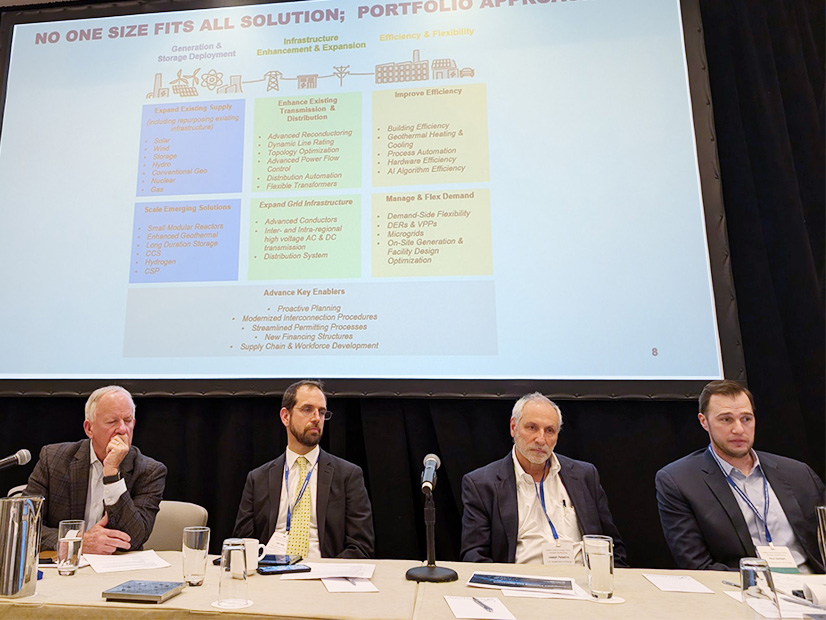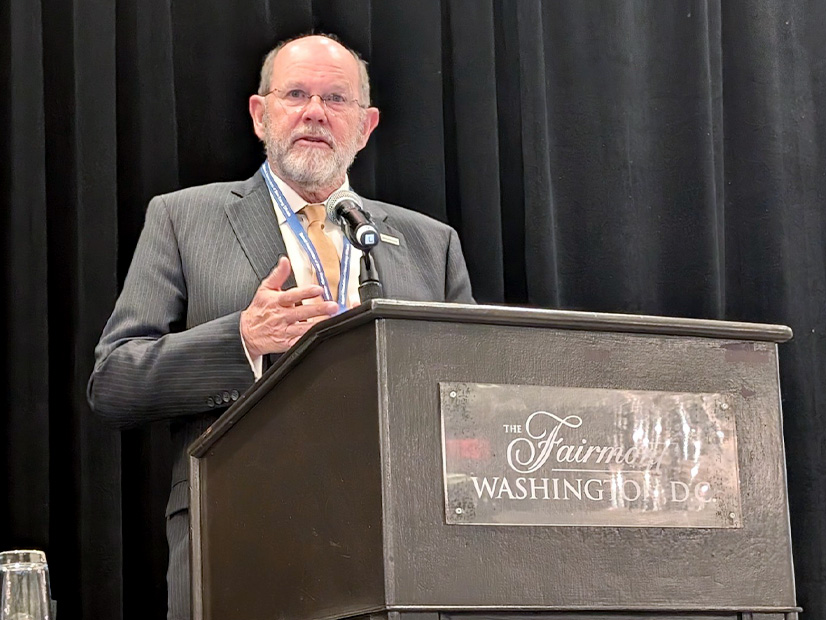
WASHINGTON — The U.S. electric power industry faces unprecedented challenges from the size, pace and impacts of demand growth and should look to new approaches for possible solutions, according to speakers at the National Association of State Energy Officials’ Energy Policy Outlook Conference on Feb. 5.
“There’s not a one-size-fits-all solution for dealing with data centers or load growth in general,” said Paul Spitsen, energy technology specialist in the U.S. Department of Energy’s Office of Strategic Programs. “You’re really going to need to take a portfolio approach, depending upon what your objectives are and what resources you have.”
Speaking on a panel on leveraging demand growth to meet state energy goals, Spitsen called for “better productive planning to minimize the buildout.”
“How do we speed up interconnection for both the end-use customer, as well as the generators that are coming online? How do we think about new financing structures to mitigate risk for all the different customer types? How do we get up to a secure supply chain?”
Such a portfolio of strategies also should move toward integrated, regional planning, said Joe Paladino, a senior adviser at DOE’s Office of Electricity. “The current institutional processes we have in place are not integrated enough for us to be able to work collectively together to really figure out what the grid investment strategy should be.
“Where we need to really head is … to enable coordinated planning across jurisdictions, from community- and customer-based systems to distribution systems to regional systems,” he said. “A key element within that is an integrated distribution planning process.”
Paladino also argued for “coordinated operations, because now, with all the myriad players that are starting to play together regionally … we have to actually start thinking about how to coordinate our operations. Grid operations work in the millisecond time frame; so, we’re going to have to understand what the latency of the information flow has to be in the system” and what kind of distributed intelligence will be needed.
Offering a real-life case study, Carl Mas — vice president for policy, analysis and research at the New York State Energy Research and Development Authority — said the state is working to develop a more coordinated approach to grid planning. (See New York Orders Utilities to Join in Proactive Grid Planning.)
NYSERDA is collaborating with NYISO, the New York Public Service Commission and other agencies on “a core, high capacity-expansion modeling and scenario-driven approach,” Mas said. “We have a lot of uncertainty in what those large loads will be. We have uncertainty as to the types of resources; so, we’re going to do a multi-scenario approach where we bring together our utilities, our ISO planners and our state planners.
“We build a database of what are the possible futures. We then take it down to each utility, analyzing their local assessment of how it can be met. We review those local solutions and then bring it back up to a least-cost planning assessment.”
An immediate challenge is that computer tools for joint optimization of local and bulk power systems are being developed at the National Renewable Energy Laboratory but don’t yet exist, he said.
NYSERDA does have an electric system infrastructure assessment tool, which provides information for “folks who are looking to site grid-edge technologies like solar, like battery storage, to be able to see where is the headroom in the system; where there is existing solar and existing storage,” Mas said.
The agency also is looking to develop “geographically specific planning tools” for local communities and even for individual buildings and lots, producing data that then can be integrated into state and regional planning, he said.
Electric, Gas Integration
In his keynote presentation at the NASEO conference, NERC CEO Jim Robb provided an overview of the ERO’s most recent long-term reliability assessment and the 132 GW of new power that, he said, will be needed over the next 10 years. (See NERC Warns Challenges ‘Mounting’ in Coming Decade.)
“A gigawatt is a load about the size of the city of San Francisco,” Robb said. “So … we’re talking about adding like 130 mid-sized cities to the country over the next 10 years.”
Taking into account the time it takes to permit generation and transmission, “about half of the country over the course of the next five years [is] at elevated risk of electricity shortfalls,” an unprecedented level of risk, Robb said. The country needs to get major amounts of new generation online “very, very quickly,” as well as the transmission required to get power to demand centers.
And because most of the projects in RTO and ISO interconnection queues are renewables — solar, wind and storage — Robb favors natural gas generation to balance the grid. But he cautioned that deregulation and restructuring of both sectors took place in “a very, very different world than what we’re in right now.”
The electric and natural gas systems need to be viewed as “a much more integrated system. Securing balancing resources is going to be really, really critical,” he said.
Citing a recent study from the Lawrence Berkeley National Laboratory, Spitsen’s estimate for demand growth was slightly less than Robb’s — 128 GW — but Spitsen stressed that data centers were not the only drivers for new generation, pointing to manufacturing, transportation and building electrification, and even oil and gas production.
“We also have extreme weather conditions across the entire country, which drive up electricity demand, and the point I want to make really is that this is going to require a kind of paradigm of transformation … [for] the utility sector and also the regulatory sector.”
The LBNL report projected that by 2028, data centers and artificial intelligence could account for as much as 12% of U.S. electricity demand.
Spitsen also said that demand from data centers will vary, from huge hyperscale centers to small enterprise systems, “and each of these different types of data centers and the different processes they have changes both the size of our load, but also the temporal profile as well.”
Freeze Update
The challenges ahead for state energy officials are shrouded in uncertainty as President Donald Trump and Energy Secretary Chris Wright push for a wholesale retreat from the climate and clean electricity goals of the Biden administration. (See DOE Official to NASEO: ‘There is not an Energy Transition’.)
The status of federal funds from the Inflation Reduction Act and Infrastructure Investment and Jobs Act has remained in flux. In a Feb. 10 order, Judge John J. McConnell Jr., of the U.S. District Court for Rhode Island, found that the White House has not fully complied with his previous temporary restraining order and stated that the administration must restore paused federal dollars as long as the order is in force.
McConnell’s order, in response to a lawsuit filed by state attorneys general, was separate from that of D.C. District Court Judge Loren AliKhan, who also issued a restraining order on the White House in a case brought by several groups, led by the National Council of Nonprofits. (See Judge Issues Restraining Order on Trump Admin over Funding Pause.)
“The states have presented evidence in this motion that the defendants in some cases have continued to improperly freeze federal funds and refused to resume disbursement of appropriated federal funds,” McConnell wrote. “The broad categorical and sweeping freeze of federal funds is, as the court found, likely unconstitutional and has caused and continues to cause irreparable harm to a vast portion of this country.”
In his first speech to DOE staff on Feb. 5, Wright did not mention renewables, energy efficiency or demand management as tools for meeting demand growth and the need for more energy in the U.S.
In contrast, Spitsen pitched the role of flexibility, including energy efficiency, in meeting demand growth, calling it “one of the untapped things we have to look forward to. But … how do you tap that? Is it a price-responsive flexibility? Is it more a centralized, control-based flexibility?”
“It’s really hard to ascertain, looking at the future, who can be flexible, who can’t, how that might change over time as their own processes and technologies change,” he said. “But it is really important. It’s a level we need to think about … to plan for.”



